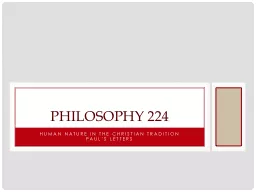

Pauls Letters Philosophy 224 The First Christian Texts Pauls letters to the Christian communities in Rome and Corinth are among the first written texts of Christianity They predate the composition of the gospels which were most likely written between 70100 CE ID: 248221
Download Presentation The PPT/PDF document "Human Nature in the Christian Tradition" is the property of its rightful owner. Permission is granted to download and print the materials on this web site for personal, non-commercial use only, and to display it on your personal computer provided you do not modify the materials and that you retain all copyright notices contained in the materials. By downloading content from our website, you accept the terms of this agreement.
Slide1
Human Nature in the Christian TraditionPaul’s Letters
Philosophy 224Slide2
The First Christian Texts
Paul’s letters to the Christian communities in Rome and Corinth are among the first written texts of Christianity.
They predate the composition of the gospels, which were most likely written between 70-100 C.E..
As such, these letters serve as a very early account of the transformation of the Jewish view of God and humanity that is characteristic of Christianity.Slide3
Who Was Paul?What we know of Paul comes largely from his letters.Most biblical scholars consider Acts
to be unreliable as biography.
The information Paul relates about himself is somewhat spotty, but there are some things we do know.
Paul (Saul) was an ethnically Jewish Roman citizen who lived from ~5-67 C. E.. He self-identified as a Pharisee (significant in class identity, culture and theology).
As we know, Paul converted to Christianity and became one of the most influential early Christian missionaries, and works attributed to him (though in some cases controversially) make up much of the New Testament.
So much so that many have argued that what we know as Christianity is essentially Pauline.Slide4
MetaphysicsAs Paul makes clear in his letter to the Romans, the acknowledgement of the divinity of Jesus changes everything.Both our sense of God and our sense of the human has to be transformed.
The result of that transformation is
metaphysical dualism
: the theory that reality is comprised of two distinct substantial orders. There is a profound metaphysical gulf between the world we live in and the world we are promised by the resurrection.
This was implicit already in the Hebrew worldview, but it become explicit for Christianity.
Consider the passages on p. 64 (8, 18-25) and p. 67 (15, 44-49).
At least as developed by early Christian theologians (especially Augustine), this dualism is obviously influenced by Greek philosophy.Slide5
Spiritual DoublesThe metaphysical dualism enshrined in Paul’s letters has immediate implications for the ontology presented.One of the key teachings of Pauline Christianity is that humans share in the divinity of Christ. Like Jesus, we are in a sense both human and divine.
As Paul presents it in his letter to the Romans (pp. 62-3), and again in his first letter to the Corinthians (pp. 67), humans are
spiritual doubles
: a theory of human nature which specifies that humans are composed of two distinct natures.
We are composed both of a human nature unavoidably enmeshed in the world and thus defined by “enmity with God” (
Romans
, 8:7) and a spiritual nature that can know and love God.Slide6
Diagnosis: SinPaul’s relationship to his Jewish heritage is most evident in his treatment of sin.His gloss on the Law (the word of God as revealed in the Torah) is that it is insufficient, “For no human being can be justified in the sight of God by keeping the law: law brings only the consciousness of sin” (
Romans
2:20).
As he radicalizes the notion of original sin at
Romans
8:22, the disobedience of Adam and Eve is seen as involving the whole of creation; everything falls short of the glory of God.
It is not just humans that are condemned to death and suffering, the ‘whole world groans.’Slide7
Prescription: IncarnationPaul’s letters are the first documents which present us with the central teachings of Christianity: the incarnation and
resurrection
.
The central claim is that God was uniquely present in Jesus, and that it is through this incarnation, death and resurrection that we are restored to our proper relationship with God (
Romans
5:18-19).
This is very familiar to us, but think how striking it is, how counter it is to our typical understanding of responsibility.
Think how really “old” it is as well; God needs blood sacrifice.Slide8
Prescription: ResurrectionAs Paul makes clear to the Corinthians, the death and resurrection of Jesus are more than just a sacrifice to a bloodthirsty God.Our doubled nature, and in particular its human dimension, can never by itself be redeemed. We too must die to sin and be reborn into life in God (
First Corinthians
15: 53-57).
We, as individuals, need to accept this salvation, an acceptance signaled by our baptism into the community of the faithful.Slide9
What about Women?As the final selection from First Corinthians reminds us, Paul was notoriously unfriendly to the possibility of gender equality in the early church and somewhat obsessive on the topic of women covering their head.
This despite the fact that in many early Christian communities there was a great deal of equality and shared authority between men and women.
And the Gospels portray Jesus as treating women, even prostitutes, with great respect.
What we should make of
this conflict is
unclear, but it is clear that it has had significant implications for women.